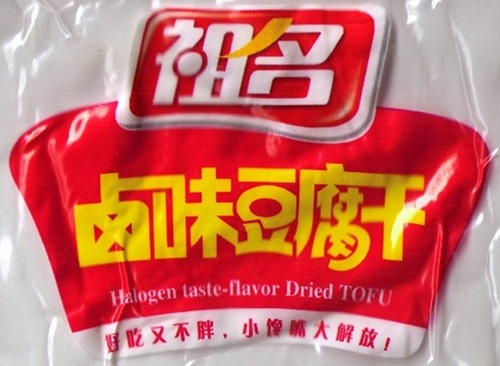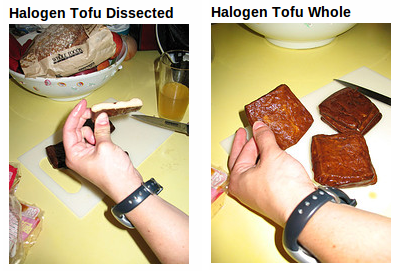Halogen flavored tofu
« previous post | next post »
Victor Steinbok has called my attention to "halogen taste-flavor dried tofu" made in China.

This sounds really strange, since the halogens (fluorine [F], chlorine [Cl], bromine [Br], iodine [I], and astatine [At]) are toxic when used improperly. In any event, they do not seem to be the sort of thing that one would want to flavor one's bean curd with.
On this page of Cultural China entitled "How to Make Tofu", it states that "Halogen is needed to change the colloid liquor into tofu, and we usually use bittern or gypsum to do it." Under the section on "Smelly Tofu" of the same page, we find that "halogen treatment" is one of the ways to process bean curd.
It seems that, in these two different sections ("How to Make Tofu" and "Smelly Tofu"), "halogen" is being used for two entirely different meanings. The first use of halogen must be intended simply to designate salts such as calcium sulphate or magnesium chloride, which are used to coagulate soymilk. The second usage, however, is mystifying and requires further investigation.
My initial forays into the literature on halogen only increased my wonderment, what with such bizarre instructions as this: "morning and evening to be boiling again, 'Irazu' generally 15 days for a flash."
The page on "How to cook 'stinky' tofu" also calls for halogen, but the instructions are such as to leave one's head spinning. The recipe begins thus: "'Stinky' tofu points South Pine and North Pine. North School is the fermented bean curd. Southern Pine is the tofu into the brine in the brine taste income, made of 'stinky' tofu. 'Stinky' tofu production method is very strange."
Indeed! Here's where the halogen comes into play: "'Stinky' tofu, its name is not the United States, outside the ugly Neixiu, flat in see odd, charming style. The choice of materials, with halogen."
Yes, truly so! Now for the spices: "the preparation of halogen stem mold Klein 5000 grams, 1,500 grams of vegetable oil, a dish of spicy at the end." Oh, now I'm getting lost.
My brother Thomas suggested that, since this is all about stinky / smelly tofu, perhaps there has been some confusion between halogen and halitosis. He changed his mind, however, when he discovered this site that offers halogen barrels for making tofu, speculating instead that halogen here "might just refer to the off-gassing during tofu production."
Here's a person eating a piece of so-called halogen-flavored dried bean curd (note the effect that it has on one's lips):

There are a couple of photos of halogen-flavored dried tofu being dissected here:

Looking at the Chinglish literature on halogen and tofu has only increased our puzzlement about what "halogen-flavored tofu" might actually be. We could have saved ourselves a lot of trouble by simply looking at the Chinese equivalent of "halogen-flavored tofu." As soon as one does that, the problem is instantly solved.
The package pictured above has, against the English "Halogen taste-flavor Dried TOFU," Lǔwèi dòufu gān 滷味豆腐乾, or as it actually appears on the package in simplified characters, 卤味豆腐干. Lǔwèi 滷味 does *not* mean "halogen-flavored"; it means "braised-flavored," where the braising liquid would include such flavorings as soy sauce, star anise, scallions, and so forth.
But how did halogens get involved? Simple: the character lǔ 滷 (also written 鹵), has three main meanings: bittern, halogen; thick sauce; braise, stew. The lǔ 滷 flavor of the dried tofu in question should be rendered as "braised" or "stewed," not "halogen." At least they did not call their product "Halogen-flavored tofu fuck (gān or gàn 干 ["dry / fuck / do / pole"])," which might well have happened from over reliance on faulty translation software, as has been amply documented on Language Log, e.g. here.
[A tip of the hat to Michael Carr]
Peter Taylor said,
February 9, 2011 @ 5:53 pm
This post would have made slightly more sense if I had known before I started reading it that "bittern" is not only the name of a subfamily of herons.
Carl said,
February 9, 2011 @ 5:59 pm
Better, tofu could have been translated as "bean corruption," which is the literal meaning of 豆 to + 腐 fu.
Nathan said,
February 9, 2011 @ 6:12 pm
Thank you so much for the information, Peter Taylor. I wouldn't have even thought to look it up without your tip.
Mr Fnortner said,
February 9, 2011 @ 6:17 pm
"Bean corruption" is sensible since tofu is the result of denaturing the protein in soy milk.
octopod said,
February 9, 2011 @ 6:21 pm
For anyone else still mystified by the unexpected bitterns, it's a word for magnesium sulphate (bischofite), specifically a word used by people who make sea salt. Yeah, I was confused too.
Also, I've totally bought that brand and always assumed it was some kind of error involving salt->NaCl->chlorine->halogens. So is this a simplified-versus-traditional problem?
David L said,
February 9, 2011 @ 6:38 pm
Wikipedia, which is not to doubted, claims that the non-avian bittern is magnesium chloride — which unlike magnesium sulphate at least has a connection to 'halogen.' But is it really the case that Chinese uses the same word for this mineral and for the elemental halogens too, or am I misunderstanding something?
David L said,
February 9, 2011 @ 6:38 pm
*be
George Amis said,
February 9, 2011 @ 8:06 pm
The braising liquid VM is talking about sounds like the basic liquid used in Chinese "red cooking". It is a mixture of stock, soy sauce, star anise and other things of that sort, and often includes scallions, garlic, and rock sugar. It is usually used to simmer meat and hard boiled eggs, but certainly could be used for tofu. The liquid is reused many times, and gets more flavorful with each use.
Rick Matz said,
February 9, 2011 @ 8:20 pm
Considering the use of toxic chemicals when painting kids toys, etc; maybe they really DO mean halogen.
Smith said,
February 10, 2011 @ 4:02 am
This is indeed another manifestation of the many perils attendant upon the use of simplified characters. In the traditional forms, the "waterless" 鹵 is used in the various chemical contexts (alkaline, halogens) and the splashy 滷 is used in the kitchen. Hence no greater confusion than among, say, rain/rein/reign, where context clarifies all. Context can in fact generally be relied upon to differentiate the various uses of the simplified (and always waterless) 卤 as well, at least until a machine is called upon to do the work of a living brain.
Lareina said,
February 10, 2011 @ 5:47 am
It can also be translated as 'marinated tofu' I guess?
I laughed at the bottom '小馋嘴大解放' for a long time…
richard howland-bolton said,
February 10, 2011 @ 7:19 am
Halogens: Hey you forgot Ununseptium :-)
Bob Violence said,
February 10, 2011 @ 12:24 pm
In the traditional forms, the "waterless" 鹵 is used in the various chemical contexts (alkaline, halogens) and the splashy 滷 is used in the kitchen.
Judging from Google results it seems that 滷 and 鹵 are either interchangeable in Hong Kong (in the 鹵味/滷味 sense) or refers to two different cooking techniques. The Wikipedia page for lou mei ("dishes made by simmering in a seasoned soy-based sauce") says it's often written both ways in traditional characters. I'm still not clear if this is the same lou mei/lǔwèi in 卤味豆腐干, although from what's been written above they sound similar enough.
Nic Vega said,
February 10, 2011 @ 2:37 pm
I'm the person eating halogen tofu in the photos! How did you find them? We had worked out that "halogen-flavor" had something to do with a re-used cooking sauce, but the breakdown of the character equivalents is very enlightening.
For the record, the flavor is… fascinating.
minus273 said,
February 11, 2011 @ 1:08 pm
The link is obviously NaCl. 卤素 (salty-element) is a calque on "halogen" (salt-origin), and 卤 the cooking technique uses 卤水 (salty-water), semantically extended to mean the spiced ingredient in 卤'd food.
q said,
February 11, 2011 @ 6:44 pm
滷 is indeed a type of marinade, quite popular in Taiwan. Go to any night market and you will see many stands offering 滷味, where the customer can pick out a number of offerings ranging from tofu, dried tofu, eggs, pork, offal, etc. which are then recooked for a few seconds in the large cauldron of 滷.
bryan said,
February 12, 2011 @ 4:30 pm
"Judging from Google results it seems that 滷 and 鹵 are either interchangeable in Hong Kong (in the 鹵味/滷味 sense) or refers to two different cooking techniques."
That's why I'd say "Google 干的": To you, it means "Google did it". To me, it means "Google fucked it up." Google it? Puh-lease. Google NEVER gives correct translations, etc…
滷 = used for cooking NO matter where you are.
鹵 = stewed food or gravy, not so much halogen or bittern.
滷 is used in Hong Kong, Taiwan, etc… = to marinade
鹵 if the person forgot that 滷 has 氵and so wrote 鹵 using just phonetically by character.
卤 = without 氵and without the four inner dots denoting the salts: What type of food is made without water and without the salts? It doesn't = halogen, unless it's chemically related, which it isn't here! That's why it's so messed up by using Simplified Chinese. Traditional Chinese would reduce the confusion.
Bob Violence said,
February 13, 2011 @ 7:14 pm
This has nothing whatsoever to do with "translations" on Google's part (where on earth did you get that from?). There are approximately equal results in the .hk domain for both 滷味 and 鹵味; among those using 鹵味 are the government-run Centre for Food Safety and the Legislative Council. Obviously this use is incorrect by your (and no doubt many others') standards, but even allowing for the limitations of this comparison — searching for 鹵味/滷味 rather than all instances of 鹵 and 滷, which would require examining the precise context of every single result;* the fact that Google results can include duplicates and can't be considered representative of an entire population; the small sample size, a result of restricting the search to the .hk domain to avoid "contamination" from mainland sites in traditional characters — the error seems rather ubiquitous and my previous post isn't contradicted.
*although a search for 鹵水 and 滷水 in the .hk domain also produces more hits for 鹵水, so the substitution isn't limited to the single word 鹵味/滷味. 滷味 and 滷水 win by big margins in the .tw domain.
heatherbt said,
June 23, 2011 @ 12:28 pm
Thank you for this. We've started buying dried tofu at the local market for the kids lunches and the flavor they like best is Halogen. I now feel reassured that we are not feeding them lighting products!
Food that Saves Energy « WTFUX said,
September 16, 2011 @ 2:24 am
[…] languagelog.ldc.upenn.edu Share this […]